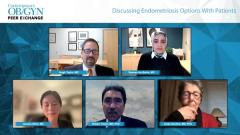
Endometriosis: Takeaway Points
Endometriosis experts describe their takeaway points messages on the management of endometriosis.
Episodes in this series

Hugh Taylor, MD: Let’s wrap up. I’ll start with some of the takeaway points from this conversation, and then I’ll let everyone add other important take-home messages for our audience. The first thing we need to do is listen to our patients, be aware of this disease, make sure our patients feel comfortable talking to us, let them know we’re open to talking about it, and catch this disease early with early clinical diagnosis. Start first-line therapy—typically that’s a progestin-based therapy, whether it’s a progestin or an oral contraceptive. But move quickly. Don’t tell them to come back in a year. Follow up in 6 to 8 weeks. Move quickly to second-line therapy if the first line is ineffective. In many patients it will be, and we use oral contraceptives not because they’re the best therapy but because they’re easy and inexpensive.
We have better therapies. Many patients will benefit from that and move to second- or third-line therapy fairly quickly to nip this in the bud, to prevent the progression of disease and restore that life trajectory that’s often hampered, especially in young women who are suffering in school or in the early stage of their career—times of life that you don’t get to do over. We need to take it very seriously and make sure that we put these people back on track as soon as possible and start to eliminate that 10-year delay to diagnosing endometriosis. Does anybody else want to add a key takeaway point?
Jessica Shim, MD: Everyone described their approach. It’s refreshing to hear that we all incorporate a lot of shared decision-making, understanding [the importance of] compliance and adherence to a medical regimen. [We should] pick 1 that the patient understands how to use, [knowing] the possible adverse effects and risks that will help the relationship and [how it will] help their endometriosis care.
Hugh Taylor, MD: I start with an oral contraceptive and then quickly go on to a GNRH antagonist. The GNRH antagonists have lowered that threshold for going to second-line therapy, where it’s only the depot agonists, which was a big hurdle.
Sawsan As-Sanie, MD: These are all excellent points. We need to remember that endometriosis is a chronic disease. Through shared decision-making, priorities for a given patient can change over time. When we’re seeing patients in their adolescent and younger years, their goals might be very different from when they’re trying to have a family. Those might be very different from those patients who are not—they’ve completed their family or that’s not their goal anymore. Picking a treatment at a given time might change over a patient’s life course. Those active conversations might also change over time.
Hugh Taylor, MD: Sawsan mentioned the fertility aspects of what a lot of our patients are looking to make, some more immediately. That’s something we haven’t addressed much today. While we’re looking for new therapeutics for pelvic pain and dysmenorrhea associated with endometriosis, we should also keep our minds open about what types of therapies we might be able to develop that will enhance the fertility of women and couples. That’s a future goal for us, trying to enhance fertility as well as treat the pain.
Linda Giudice, MD, PhD: Those who are going to be treating patients with endometriosis should feel empowered to make the diagnosis and establish relationships with a referral base for a multidisciplinary approach. Also, we’re entering an age where we have more flexibility for dosing. Sawsan mentioned personalized medicine. We have GNRH antagonists that we can give as 2 doses, a 1-dose combination, or not in combination. These things will be very empowering for physicians, nurse practitioners, and others who care for our patients, and you don’t have to be a reproductive endocrinologist to prescribe these medications. The onus is on us, as a community, to educate our clinical colleagues with regard to the disease and the medical options and to hopefully establish a referral basis for a multidisciplinary approach.
Hugh Taylor, MD: Thank you all. It’s been a treat having this discussion with other endometriosis experts. It’s been a privilege talking to you all. I want to thank our audience for watching Contemporary OB/GYN® Peer Exchange. If you’ve enjoyed this content, you can subscribe to the e-newsletter to receive upcoming Peer Exchanges and other great content in your email in-box. Thank you.
TRANSCRIPT EDITED FOR CLARITY
Newsletter
Get the latest clinical updates, case studies, and expert commentary in obstetric and gynecologic care. Sign up now to stay informed.


























